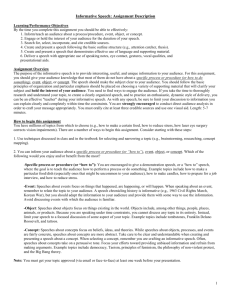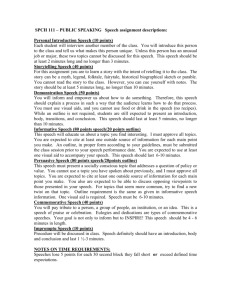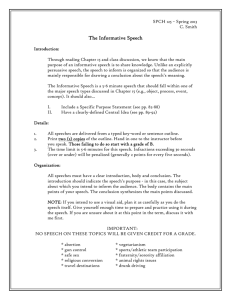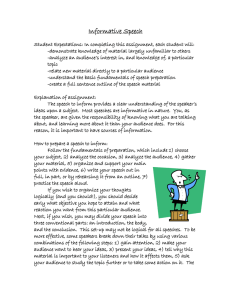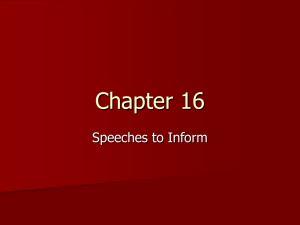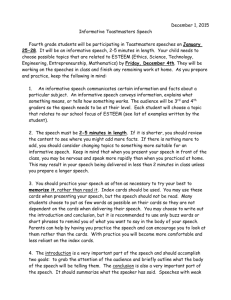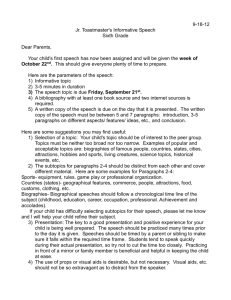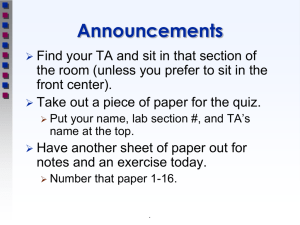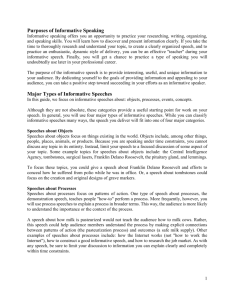Informative Speech Guidelines_3
advertisement
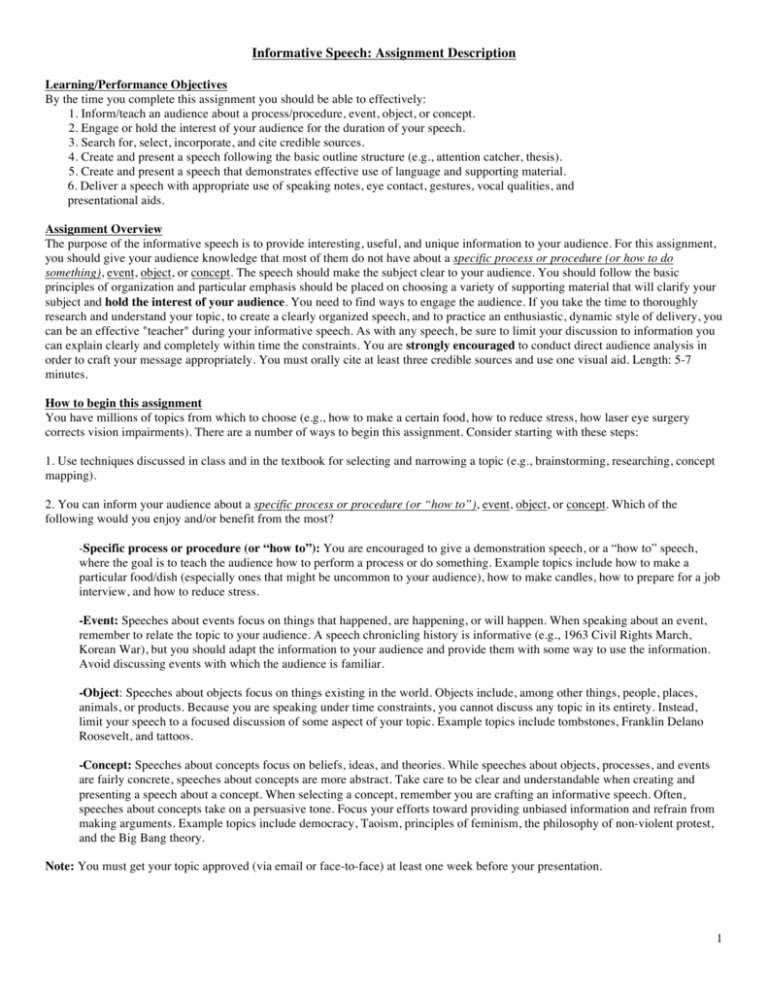
Informative Speech: Assignment Description Learning/Performance Objectives By the time you complete this assignment you should be able to effectively: 1. Inform/teach an audience about a process/procedure, event, object, or concept. 2. Engage or hold the interest of your audience for the duration of your speech. 3. Search for, select, incorporate, and cite credible sources. 4. Create and present a speech following the basic outline structure (e.g., attention catcher, thesis). 5. Create and present a speech that demonstrates effective use of language and supporting material. 6. Deliver a speech with appropriate use of speaking notes, eye contact, gestures, vocal qualities, and presentational aids. Assignment Overview The purpose of the informative speech is to provide interesting, useful, and unique information to your audience. For this assignment, you should give your audience knowledge that most of them do not have about a specific process or procedure (or how to do something), event, object, or concept. The speech should make the subject clear to your audience. You should follow the basic principles of organization and particular emphasis should be placed on choosing a variety of supporting material that will clarify your subject and hold the interest of your audience. You need to find ways to engage the audience. If you take the time to thoroughly research and understand your topic, to create a clearly organized speech, and to practice an enthusiastic, dynamic style of delivery, you can be an effective "teacher" during your informative speech. As with any speech, be sure to limit your discussion to information you can explain clearly and completely within time the constraints. You are strongly encouraged to conduct direct audience analysis in order to craft your message appropriately. You must orally cite at least three credible sources and use one visual aid. Length: 5-7 minutes. How to begin this assignment You have millions of topics from which to choose (e.g., how to make a certain food, how to reduce stress, how laser eye surgery corrects vision impairments). There are a number of ways to begin this assignment. Consider starting with these steps: 1. Use techniques discussed in class and in the textbook for selecting and narrowing a topic (e.g., brainstorming, researching, concept mapping). 2. You can inform your audience about a specific process or procedure (or “how to”), event, object, or concept. Which of the following would you enjoy and/or benefit from the most? -Specific process or procedure (or “how to”): You are encouraged to give a demonstration speech, or a “how to” speech, where the goal is to teach the audience how to perform a process or do something. Example topics include how to make a particular food/dish (especially ones that might be uncommon to your audience), how to make candles, how to prepare for a job interview, and how to reduce stress. -Event: Speeches about events focus on things that happened, are happening, or will happen. When speaking about an event, remember to relate the topic to your audience. A speech chronicling history is informative (e.g., 1963 Civil Rights March, Korean War), but you should adapt the information to your audience and provide them with some way to use the information. Avoid discussing events with which the audience is familiar. -Object: Speeches about objects focus on things existing in the world. Objects include, among other things, people, places, animals, or products. Because you are speaking under time constraints, you cannot discuss any topic in its entirety. Instead, limit your speech to a focused discussion of some aspect of your topic. Example topics include tombstones, Franklin Delano Roosevelt, and tattoos. -Concept: Speeches about concepts focus on beliefs, ideas, and theories. While speeches about objects, processes, and events are fairly concrete, speeches about concepts are more abstract. Take care to be clear and understandable when creating and presenting a speech about a concept. When selecting a concept, remember you are crafting an informative speech. Often, speeches about concepts take on a persuasive tone. Focus your efforts toward providing unbiased information and refrain from making arguments. Example topics include democracy, Taoism, principles of feminism, the philosophy of non-violent protest, and the Big Bang theory. Note: You must get your topic approved (via email or face-to-face) at least one week before your presentation. 1 Staple to top of outline Name: Informative Speech Comment Form How many times did you practice? Topic approved (yes/no) *Note: You must get your topic approved Comments √Introduction Initial ethos (credibility before speaking) Attention catcher Thesis statement Listener relevance Preview of main points Body Main points clear and organized Supporting material (examples, testimony, etc.) Use of transitions/signposts Clear organization Effective/appropriate content Orally cite 3 sources during speech Conclusion Thesis restatement Summary of main points Clincher and obvious conclusion Language Descriptive; linguistic tools (metaphors) Effective placement of details Delivery Eye contact (90%; span the audience) Hand and facial gestures Posture and speaking position Conversational in tone Voice: volume, rate, pauses Diction (clarity of words) Minimal fillers (“ah,” “um,” “you know”) Minimal use of notes Visual aid Spoke to audience, not aid Size, neatness, centered Disclosed/concealed appropriately √ √+ Points Received Points Possible1 3.0 8.0 3.0 3.0 7.0 2.0 Explained clearly; clarifies verbal message Audience engagement 2.0 Outline (complete sentence, sources in APA) Time: Total 2.0 30.0 1 √- = Needs significant improvement; poor √ = Needs some improvement; average √+= Superb; excellent You will receive a deduction if this form is not stapled to the top of your outline at the time of your speech, if you do not include your name or times practiced on this form, if you do not get your topic approved, or if you violate the time restrictions (5-7 minutes). 2
